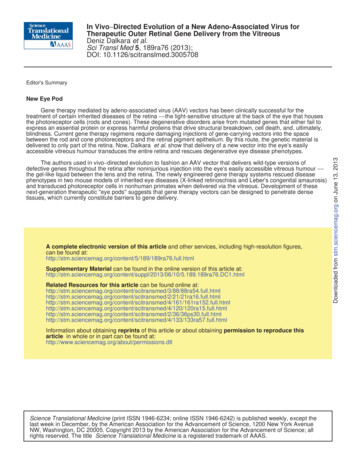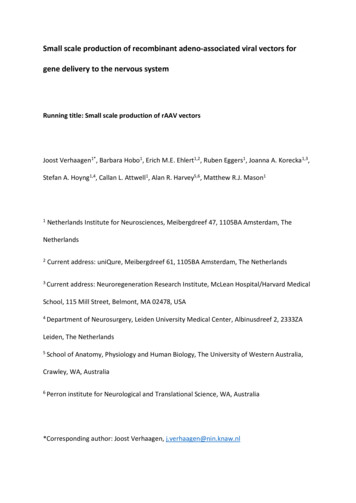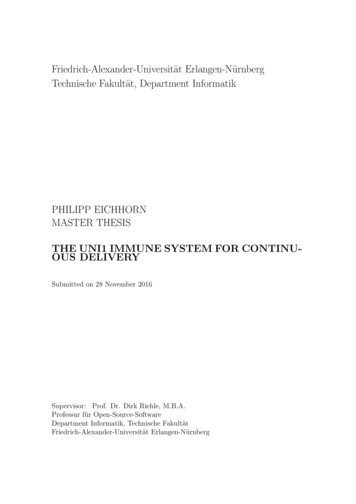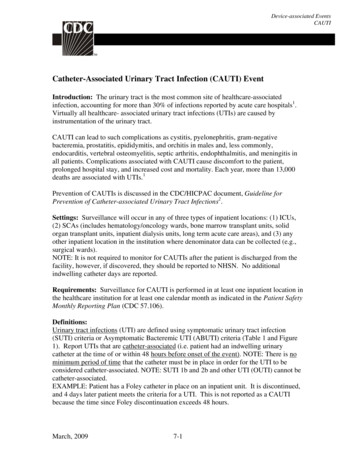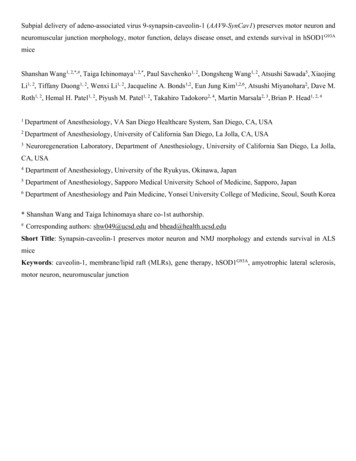
Transcription
Subpial delivery of adeno-associated virus 9-synapsin-caveolin-1 (AAV9-SynCav1) preserves motor neuron andneuromuscular junction morphology, motor function, delays disease onset, and extends survival in hSOD1G93AmiceShanshan Wang1, 2,*,#, Taiga Ichinomaya1, 2,*, Paul Savchenko1, 2, Dongsheng Wang1, 2, Atsushi Sawada5, XiaojingLi1, 2, Tiffany Duong1, 2, Wenxi Li1, 2, Jacqueline A. Bonds1,2, Eun Jung Kim1,2,6, Atsushi Miyanohara2, Dave M.Roth1, 2, Hemal H. Patel1, 2, Piyush M. Patel1, 2, Takahiro Tadokoro2, 4, Martin Marsala2, 3, Brian P. Head1, 2, #1Department of Anesthesiology, VA San Diego Healthcare System, San Diego, CA, USA2Department of Anesthesiology, University of California San Diego, La Jolla, CA, USA3Neuroregeneration Laboratory, Department of Anesthesiology, University of California San Diego, La Jolla,CA, USA4Department of Anesthesiology, University of the Ryukyus, Okinawa, Japan5Department of Anesthesiology, Sapporo Medical University School of Medicine, Sapporo, Japan6Department of Anesthesiology and Pain Medicine, Yonsei University College of Medicine, Seoul, South Korea* Shanshan Wang and Taiga Ichinomaya share co-1st authorship.#Corresponding authors: shw049@ucsd.edu and bhead@health.ucsd.eduShort Title: Synapsin-caveolin-1 preserves motor neuron and NMJ morphology and extends survival in ALSmiceKeywords: caveolin-1, membrane/lipid raft (MLRs), gene therapy, hSOD1G93A, amyotrophic lateral sclerosis,motor neuron, neuromuscular junction
1ABSTRACT2Elevating neuroprotective proteins using adeno-associated virus (AAV)-mediated gene delivery shows3great promise in combating devastating neurodegenerative diseases. Amyotrophic lateral sclerosis (ALS)4is one such disease resulting from loss of upper and lower motor neurons (MNs) with 90-95% of cases5sporadic (SALS) in nature. Due to the unknown etiology of SALS, interventions that afford neuronal6protection and preservation are urgently needed. Caveolin-1 (Cav-1), a membrane/lipid rafts (MLRs)7scaffolding and neuroprotective protein, and MLR-associated signaling components are decreased in8degenerating neurons in postmortem human brains. We previously showed that, when crossing our9SynCav1 transgenic mouse (TG) with the mutant human superoxide dismutase 1 (hSOD1G93A) mouse10model of ALS, the double transgenic mouse (SynCav1 TG/hSOD1G93A) exhibited better motor function11and longer survival. The objective of the current study was to test whether neuron-targeted Cav-112upregulation in the spinal cord using AAV9-SynCav1 could improve motor function and extend longevity13in mutant humanized mouse and rat (hSOD1G93A) models of familial (F)ALS.14Methods: Motor function was assessed by voluntary running wheel (RW) in mice and forelimb grip15strength (GS) and motor evoked potentials (MEP) in rats. Immunofluorescence (IF) microscopy for16choline acetyltransferase (ChAT) was used to assess MN morphology. Neuromuscular junctions (NMJs)17were measured by bungarotoxin-a (Btx-a) and synaptophysin IF. Body weight (BW) was measured18weekly, and the survival curve was determined by Kaplan-Meier analysis.19Results: Following subpial gene delivery to the lumbar spinal cord, male and female hSOD1G93A mice20treated with SynCav1 exhibited delayed disease onset, greater running-wheel performance, preserved21spinal alpha-motor neuron morphology and NMJ integrity, and 10-12% increased longevity, independent22of affecting expression of the mutant hSOD1G93A protein. Cervical subpial SynCav1 delivery to23hSOD1G93A rats preserved forelimb GS and MEPs in the brachial and gastrocnemius muscles.24Conclusion: In summary, subpial delivery of SynCav1 protects and preserves spinal motor neurons, and25extends longevity in a familial mouse model of ALS without reducing the toxic monogenic component.
26Furthermore, subpial SynCav1 delivery preserved neuromuscular function in a rat model of FALS. The27latter findings strongly indicate the therapeutic applicability of SynCav1 to treat ALS attributed to28monogenic (FALS) and potentially in sporadic cases (i.e., SALS).
29INTRODUCTION30Amyotrophic lateral sclerosis (ALS) derives its name from denervational atrophy of the muscles in31the tongue, oropharynx, and limbs (amyotrophy), degenerating corticospinal axons resulting in thinning32and scarring (sclerosis) of the lateral spinal cord, and thinning of the ventral roots. ALS is a progressive,33paralytic disease due to loss of motor neurons (MN) in the brain and spinal cord. ALS signs include diffuse34muscle weakness, fasciculations (spontaneous muscle twitching), hyperreflexia (upper), and paralysis35(lower), and ultimately reducing life expectancy to 2-5 years [1, 2]. In addition to these motor-associated36pathologies, 15-20% of ALS cases also exhibit cognitive deficits as a result of degeneration of the frontal37and temporal lobes (frontotemporal dementia or FTD) [3]. Incidence of ALS is 3-5 per 100,000 persons38globally and is present in both dominantly inherited familial (FALS, 5-10%) and sporadic (SALS, 90-3995%) forms [2]. Typical age-of-onset is 58-63 years and 47-52 years for SALS and FALS, respectively,40with both being phenotypically similar. Unfortunately, the current FDA-approved treatments for ALS41including Rilutek (riluzole, a glutamate antagonist) [1] and Radicava (edaravone, a free radical scavenger)42[4] only provide limited extension of life; the former acts by attenuating excessive motor neuron firing43and the latter works by decreasing oxidative stress.44For FALS, genetic interventions focused on knocking down key genes such as mutant form of super45oxide dismutase 1 (SOD1) [5], however, due to the lesser-known etiology of SALS, a successful therapy46for ALS will most likely require combinatorial neuroprotective interventions. What is known about ALS,47including FALS and SALS, is that they are highly complex, heterogeneous neuropathological conditions48resulting from motor neuronal loss due to a highly neurotoxic environment [6-10]. Therefore,49interventions that provide neuroprotection may preserve motor neuron survival and neuromuscular50function even in the presence of known monogenic mutations or unknown sporadic etiology.51Previously we showed that neuron-targeting of the membrane/lipid raft (MLR) protein caveolin-152(using a synapsin-driven Cav-1 engineered construct termed SynCav1) promotes hippocampal synaptic53and neuroplasticity [11], significantly improves learning and memory in aged mice, and preserves learning
54and memory in an Alzheimer’s disease (AD) mouse model independent of reducing amyloid plaques [12].55Moreover, when crossing our SynCav1 transgenic mouse (TG) with the hSOD1G93A mouse model of ALS,56we observed preserved body weight (BW), longer survival, better running wheel (RW) performance,57preserved spinal cord α (alpha) motor neurons, and more MLR-associated neurotrophin receptors (NTRs)58in the spinal cord. In terms of human clinical relevance, a seminal finding from the United Kingdom59(University of Sheffield) revealed decreased Cav-1 protein expression and disrupted MLRs in samples60from sporadic human ALS cases due to mutations in the Cav-1 DNA enhancer region, suggestive of a61novel ALS-associated risk variant [13].62One of the major challenges of treating neurodegenerative diseases, including ALS and AD, is to find63the most effective manner by which to deliver vectors while minimizing the off-target effect. Although64some have demonstrated penetration into the central nervous system and spinal cord using intrathecal or65intraventricular delivery using high titers of genetic material, which unfortunately limits the effectiveness66and safety of using AAV9-based vectors to treat afflicted spinal cord and brain tissue in ALS [14-17]. To67achieve broader tissue distribution with greater efficacy, the current study utilized the novel spinal subpial68(SP) vector delivery route developed by the Marsala laboratory [14].69Over the past few years, the predominant approach to treat ALS is to target known monogenic causes70of FALS [15, 18-23]. Instead of targeting the genes or proteins attributed to the gain of toxicity, the present71study tested the hypothesis that subpial delivery of neuroprotective AAV9-SynCav1 to the spinal cord of72hSOD1G93A mice may mitigate disease progression, protect motor neurons, maintain neuromuscular73junctions (NMJs), and extend survival, independent of targeting mutant hSOD1G93A protein. We now show74for the first time that a one-time subpial delivery of AAV9-SynCav1 to hSOD1G93A mice at lumbar section75significantly extends longevity and preserves BW in both male and female mice, preserves lumbar motor76neuron morphology and neuromuscular junction (NMJ) morphology in the lower limb muscle, and77maintains better RW performance independent of affecting expression of mutant hSODG93Aprotein. This78study further extends the neuroprotective and therapeutic potential of SynCav1 gene therapy to another
79distinct neurodegenerative condition (i.e., ALS), irrespective of disease etiology, and thus SynCav1 has80the potential to treat a variety of neurodegenerative conditions attributed to either familial or sporadic81forms. Furthermore, SynCav1 gene therapy may work synergistically in combination with other82interventions (e.g., antisense oligonucleotides, antibodies, small molecules) that specifically target83monogenic familial forms of ALS and other neurodegenerative conditions.8485Materials and Methods86Animal87Human mutant superoxide dismutase-1 (hSOD1G93A)-transgenic (Tg) and C57BL/6 mice were88purchased from Jackson Laboratory (Bar Harbor, ME, USA) and bred in-house. Wild type (WT)89littermates were used as control. All animal protocols were approved by the Veterans Administration San90Diego Healthcare System Institutional Animal Care and Use Committee (#A20-030). Mice were reared91(3-5/cage) with free access to food and water. WT, and hSOD1G93A mice were allocated to 4 groups92randomly: WT, hSOD1G93A naïve (no surgery), hSOD1G93A control (subpial surgery with same volume93of AAV9-SynNull or saline), and hSOD1G93A SynCav1 to receive subpial lumbar vector injections. Spinal94cord tissue was processed for biochemistry, histopathology, and immunofluorescence at the indicated time95points.96Sprague-Dawley rats were treated in compliance with the Guide for the Care and Use of Laboratory97Animals (National Institutes of Health) in the Marsala lab and approved by UCSD. Transgenic rats98expressing ALS-linked human SOD1 mutant protein (hSOD1G93A) exhibit an ALS-like neurodegenerative99phenotype characterized by diminished body weight from muscle atrophy, weakness/paralysis,100fasciculations, and early death, along with reductions in functional cortical alpha motor neurons and101ventral horn alpha motor neurons that can be observed histologically [24]. The hSOD1G93A transgenic102male rats (Marsala lab, UCSD) were bred with WT female rats to produce WT and hSOD1G93A positive103male rats.
104105hSOD1G93A Genotyping106hSOD1G93A mice and rats were confirmed by genomic DNA extraction and PCR using the Qiagen107DNeasy Blood and Tissue Kit (69504; Qiagen, Valencia, CA, USA). PCR was performed for the hSOD1108genes by using the following protocol: denaturation at 94 C for 2 min, followed by 10 cycles at 94 C for10920 s, 65 C for 15 s (- 0.5 per cycle decrease), and 68 C for 10 s, then followed by 28 cycles at 94 C for11015 s, 60 C for 15 s, 72 C for 10 s, then 72 C for 2 min and hold at 10 C. All primers were purchased111from Integrated DNA Technologies (Coralville, IA, USA). hSOD1G93A-positive mice were confirmed112using the following primers: primer 1, hSOD1 Forward [CAT CAG CCC TAA TCC ATC TGA113(oIMR0113)]; primer 2, hSOD1 Reverse [CGC GAC TAA CAA TCA AAG TGA (oIMR0114)]; primer1143, Internal control Forward [CTA GGC CAC AGA ATT GAA AGA TCT (oIMR7338)]; and primer 4,115Internal control Forward [GTA GGT GGA AAT TCT AGC ATC ATC C (oIMR7339)]. These primers116were used to detect a product size of 800 for mouse endogenous SOD1 and 600 base pair (bp) for human117SOD1 as previously described [25]. Transgenic rats were genotyped by PCR amplification for the118hSOD1G93A. PCR products were separated on a 1% agarose gel (35 min at 135 volts).119120Viral vectors and SynCav1 Construct121A self-complementary AAV (scAAV) construct expressing neuron specific synapsin (Syn) promoter122with the Cav-1 cDNA was generated at the UCSD Viral Vector core as previously described [12]. To link123the neuron specific synapsin (Syn) promoter with the Cav-1 cDNA, an XbaI-SalI DNA fragment124containing the Syn promoter was inserted into the NheI-SalI sites of pEGFP-N1 (Clontech). The resulting125plasmid was designated pSyn-EGFP. A 537 bp Cav-1 cDNA was isolated from the pCRII-TOPO vector126(Invitrogen) by digestion with PmeI-NotI and inserted into the SmaI-NotI site of the pSyn-EGFP to127generate pSyn-Cav-1, in which the EGFP gene was replaced with Cav-1 cDNA. The Syn-promoter-Cav-1281 cassette was isolated from pSyn-Cav-1. The scAAV vector construct, expressing Cav-1 or RFP driven
129by the Syn promoter, was made by DNA synthesis of the Syn promoter (480 bp) through Cav-1 (537 bp)130or enhanced RFP (700 bp) and cloning it into an scAAV backbone plasmid. The scAAV9-SynCav1,131scAAV9-SynRFP, or scAAV9-SynNull vectors were produced by transient transfection of HEK293T cells132with each vector plasmid, pRep2/Cap9 and pAd-Helper plasmid. Helper virus-free AAV vectors were133produced by Polyethylenimine (PEI)-mediated transient co-transfection of HEK293T cells with three134plasmids [pVector, pRep2/CapX (X stands for each serotype) and pAd-Helper]. Cells were collected at13572 hrs post-transfection and cell lysates were made by 3x freeze/thaw cycle. AAV vectors in the cell136lysates were purified by combination of sucrose-cushion ultracentrifugation and anion-exchange column137chromatography. Virus titers were measured by real-time Q-PCR to determine genome copy (g.c.) number138in the vector preparations (g.c./ml) as a measure of AAV particles with full genome content. Final virus139titers for all three vectors are 2.0 x1013 g.c./ml.140141Subpial surgery and AAV administration142All surgical procedures were done under sterile conditions and approved by the local IACUCs. Mouse143subpial procedure: Lumbar (L1–L3) subpial vector injection in mice was performed as previously144described [14]. Briefly, mice were anesthetized with 2–3% isoflurane, the surgical area was shaved and145cleaned, and a skin incision was made at the thoracic 12 (T12)–L1 vertebral level. Under the dissecting146microscope, a dorsal laminectomy of the thoracic (T13) vertebrae was performed, and the dura overlying147the lumbar (L1) spinal segments was cut open using a 31- gauge (G) needle. The pia mater was then148punctured using a 36-G pia-penetrating needle, followed by the insertion of a blunt 36-G injection needle149containing the scAAV9 vector. Both the pia-penetrating and the subpial injection needles were mounted150on fine XYZ manipulator with needle holder (SM-15HE, Narishige, Japan). Rat subpial procedure: Wild151type (WT) or hSOD1G93A Sprague Dawley rats were anesthetized by isoflurane with 2% in room air and152placed into a Lab Standard Stereotaxic frame (Stoelting, Wood Dale, IL). Rats were elevated 3 cm by153placing on a plastic box. A homeothermic heating blanket which was set at 37 C with feedback from a
154rectal thermometer (Harvard Apparatus, Holliston, MA) was used to maintain body temperature of rats155during the procedure. Rats were then placed in Spine Adaptors (Stoelting, Wood Dale, IL) and a C4-5156laminectomy was performed to expose the dorsal surface of spinal segment C4-5 using an air-powered157dental drill and binocular microscope. The dura and pia mater were carefully incised using a 27- G needle158and a polyethylene tubing catheter, of which its size was 0.008 ID x 0.02 OD, (SAI infusion technologies,159Lake Villa, IL) was inserted into the subpia-space. Injections were made using 100-μL Hamilton Gas160Tight syringe (Hamilton, Reno, NV). Mice received a total of 10 µl to the lumbar spinal cord and rats161received a total of 20 µl of AAV9-SynCav1 ( 2.0 x 1013 genome copies (g.c.)/ml) vector to the cervical162spinal cord by subpial delivery (5 µl bilateral to the lumbar spinal cord, 10 µl total over 600 s for mice;16310 µl bilateral to the cervical spinal cord, 20 µl total over 600 s for rats) using a 50 μl Hamilton syringe164and digital infusion pump (Microinjector MINJ-PD, Tritech Research). After vector delivery, the muscle165and skin were closed using 7/0 Prolene and suture clips. Before recovery from anesthesia, the animals166received subcutaneous fluids, antibiotics (cefazolin sodium 50 mg/kg) and the initial dose of pain167medication (slow release Buprenex 0.05 mg/kg). Control group received laminectomy and subpial168injection of or equal volume of either AAV9-SynNull or sterilized saline.169170Assessment of disease onset and survival171Disease onset and late disease were retrospectively defined as the first sign of weight loss from peak172body weight and 10% weight decline from peak body weight, respectively [18, 26, 27]. Survival analyses173were performed using Kaplan-Meier analyses as previously described [25]. Survival endpoint is defined174by the inability of the mouse to adjust itself within 30 seconds (s) when placed on its back, a humane175endpoint that guarantees that animals are euthanized before they are unable to eat or drink.176177Voluntary running wheel (RW)
178At 8 and 16-week-age, mice were housed individually in plastic cages measuring 40 x 40 x 35 cm179(length x width x height) with a 11.5 cm diameter running wheel mounted on the cage side (SuperFlex180Open Field, Omnitech Electronics, Inc., Ohio, USA). The mice had free access to food and water ad181libitum and were checked daily for health and wellness. The mice had open access to running wheels182under conditions of a 12 h light/dark cycle (lights off from 6 AM to 6 PM). The duration of each183experiment was 36 h including 2 dark cycles. The mice will be placed in the cages at least 24h prior to184data collection. A sensory beam, connected to a desktop computer via a software (Fusion v6.5 r9999185SuperFlex Edition, Omnitech Electronics, Inc., Ohio, USA), was used to record wheel rotations. Running186velocity (m/min), and total distance (m) were used for analysis.187188Motor Evoked Potential (MEP)189Rats were anesthetized by intramuscular injection of ketamine (100 mg/kg) for motor-evoked190potentials (MEP) recordings in the branchial or gastrocnemius muscles. Two 30-G stimulating electrodes191were placed subcutaneously overlying the left and right motor cortex. In all rats, MEP of upper forelimb192(brachial) and lower limb (gastrocnemius) were recorded from the muscles elicited by transcranial193electrical stimulation with a pulse duration of 200 μs at 15 mA. Recording electrodes were connected to194an active head stage (Warner Instruments, Hamden, CT), and the recorded signal is amplified using DP-195311 differential amplifier (Warner Instruments, Hamden, CT). The amplified signal was acquired by the196PowerLab 8/30 data acquisition system (ADInstruments, Australia) at sampling frequency of 20 kHz,197digitized and stored using LabChart 7 (ADInstruments, Australia) in PC for analysis.198199Grip Strength200Cohorts of age-matched transgenic rats and littermate controls were tested for loss of forelimb grip201strength by using a grip strength meter (AMETEK, Inc., Berwyn, PA) at 8 wk (before subpial-injection)202and weekly from 10 to 20 wk. Rats were held in front of a horizontal bar, such that only the forelimb paws
203were able to grasp the bar. The rats were gently pulled back with steady force until both paws released the204bar. Each rat was given 6 attempts and the mean grip strength was recorded for analysis.205206Immunofluorescence (IF) Microscopy207Motor neuron morphology and Cav-1 target validation was assessed by IF. Specifically, mice were208perfused with saline and the spinal cord was dissected followed by 48 hrs post-fix in z-fix (ANATECH,209#170) and dehydration in 30% sucrose. 30 µm thickness coronal spinal cord section was then incubated210with Alexa Fluor 488 conjugated anti-choline acetyltransferase (ChAT) (abcam, ab225263, 1:400) and211Alexa Fluor 594 conjugated caveolin-1 antibody (7C8) (Novus biologicals, NB100-615AF594, 1:1000)212for overnight at 4 C. Nuclei were counterstained with antifade DAPI mounting medium (ProLong Gold213antifade mounting medium with DAPI, P36931; Invitrogen, Waltham, MA, USA). A minimum of three214coronal spinal cord sections per mouse were used for quantitation of motor neuron.215For NMJ analysis, 30 µm thickness horizontal gastrocnemius muscle section was stained with 488-216conjugated bungarotoxin-a (Btx-a) (B13422; 1:250; Invitrogen) to label post-synaptic structure and217synaptophysin (ab32594; 1:200, abcam) to label pre-synaptic vesicles followed by 1 h incubation of218secondary (Alexa Fluor 568, 1:200; B13422, Invitrogen, Waltham, MA, USA) at room temperature.219Occupancy of synaptophysin labeled presynaptic structure in Btx-a labeled postsynaptic was analyzed to220assess NMJ morphology [28]. Slides were imaged using Keyence All in One microscopy (BZ-X700,221Keyence corporation of America, IL, USA) and confocal laser microscopy (A1; Nikon, Tokyo, Japan), Z222stack with 10um was taken and projected to a single image for analysis.223224Biochemical Characterization of Membrane/Lipid Rafts (MLRs) and Immunoblot (IB) assay225Thoracic (T12) to lumbar (L2) spinal cord tissue were homogenized at 4 C in 500 mM sodium226carbonate (pH 11.0) (containing protease and phosphatase inhibitors) and then sonicated 3x for 15 s.
227Samples (0.5 mg/ml) were subjected to sucrose density gradient fractionation as previously described [29].228Homogenates and fractions were immunoblotted using primary antibodies Cav-1 (Cell Signaling #3268;2291:1000), B8H10 (Medimabs MM-0070-P, 1:500), ChAT (Millipore, AB144P, 1:1000), and GAPDH (Cell230Signaling #2118s; 1:1000) overnight at 4 C followed by incubation with IR-dye labeled secondary231antibody for 1 hour. Membranes were scanned by LiCor Odyssey followed by densitometric analysis.232233Statistical analysis234Sample size is indicated under each section of the Methods and in the figure legends. Before235determining statistical significance, data were checked for normal distribution. Data were analyzed by236Student’s t test, one-way analysis of variance (ANOVA) or 2-way ANOVA followed by Fisher’s LSD,237Tukey’s, Šídák's, or Bonferroni’s multiple comparisons post hoc analyses as appropriate using Prism 7238software (GraphPad, La Jolla, CA, USA). The Kaplan-Meier survival curve was analyzed using a log-239rank test. Mean and median survival were analyzed by an unpaired Student’s t-test. Significance was240assumed when P 0.05. All experimental groups were blinded, and code was broken only for analysis.241For correlation analysis, a simple linear regression with 95% confidence intervals was performed.242243RESULTS244AAV9-SynCav1 delivery to the lumbar spinal cord increases Cav-1 protein expression in the lumbar245and thoracic cord246Previous work from other groups have reported that the occurrence of symptomatic onset varies from2478 to 12 weeks (wk) [30] in the hSOD1 G93A mice using different methods and parameters [31, 32]. For248example, motor deficits and motor unit loss in lower limb muscle due to selective preferential vulnerability249of large, fast motor units, innervated by large motor neurons was observed in 8 wk hSOD1G93A mice,250several weeks prior to the standard measurable onset of overt clinical symptoms in this mouse model [33-25135]. To achieve effective AAV9 transduction of spinal cord motor neurons and peak expression of the
252Cav-1 transgene (which takes approximately 3-4 wk post AAV delivery), we chose to deliver AAV9-253SynCav1 at week 8 via subpial delivery, a highly effective route of administration used to accomplish254effective strong transgene expression in the mammalian spinal cord [11, 12]. As shown in Figure 1, lumbar255subpial delivery of AAV9-SynRFP resulted in a strong expression of RFP in the lower thoracic up to256lumbar (T11 to L5), with minimal expression detected in upper thoracic and cervical regions. Our previous257study demonstrated that SynCav1 / hSOD1G93A transgenic mice exhibit slowing of disease progression,258we therefore initially performed a dose-dependent study for subpial AAV9-SynCav1 delivery to determine259the optimal dose necessary to achieve Cav-1 protein expression in the spinal cord similar to that measured260in SynCav1 transgenic mice [25]. As shown in Figure S1, the optimal dose of AAV9-SynCav1 to achieve2614-fold Cav-1 overexpression in the thoracic and lumbar spinal cord was 2 x 1011 total g.c. (10 µl of 2 x2621013 g.c./ml). This dose was used in all the following studies.263264AAV9-SynCav1 significantly delays BW loss and disease onset, and extends survival in hSOD1G93A265mice266We next assessed whether subpial delivery of AAV9-SynCav1 could provide therapeutic benefit to the267hSOD1G93A mouse model of ALS. As shown in Figure 2A and 2B, compared to hSOD1G93A control,268hSOD1G93A AAV9-SynCav1 mice showed significantly delayed BW loss in both sexes. As shown in269Figure 2C and 2D, average disease onset of hSOD1G93A AAV9-SynCav1 mice was 18 wk for male (vs27015 wk hSOD1G93A control male) and female (vs 16 wk hSOD1G93A control female), an approximately27115% delay compared to the control group. In terms of disease progression, late disease onset (i.e., 10%272decrease from peak BW) [26] was measured at 20 wk for both male and female hSOD1G93A control273mice, while AAV9-SynCav1-treated hSOD1G93A female mice exhibited delayed late disease onset until 23274wk ( 11% BW decline); AAV9-SynCav1-treated hSOD1G93A male mice only exhibited 4% BW decline275at 22 wk (end of body weight record due to loss of multiple objects in the hSOD1G93A control groups).
276In terms of survival, although subpial surgery had no effect on survival rates for hSOD1G93A control277versus hSOD1G93A naïve, we observed a greater decline in BW in the sham surgery control group278compared to naïve hSOD1G93A mice between 18-22 wk (Figure 2A and 2B), indicating that subpial surgery279alone appeared to impact disease progression. Because of this effect caused by the subpial procedure280alone, for all subsequent assays (RW, histological quantitation of MN and NMJ morphology), Student’s281t-test comparison was performed only within the non-surgery (i.e., WT vs hSOD1G93A naïve) and the282surgery group (i.e., hSOD1G93A control vs hSOD1G93A SynCav1 groups) to remove the confounding283effects from subpial surgery on any measurable efficacy afforded by SynCav1 gene delivery. As shown in284Figure 2E-2F, AAV9-SynCav1 gene delivery significantly extended survival in male (10%) and female285(12%) hSOD1G93A mice when compared to hSOD1G93A control mice (Figure 2E, median male survival286days (d): hSOD1G93A SynCav1 (178 d) vs hSOD1G93A control (162 d), ***p 0.0046, Kaplan-Meier;287n 11-18; Figure 2F, median female survival: hSOD1G93A SynCav1 (181 d) vs hSOD1G93A control288(162 d); ****p 0.0001, Kaplan-Meier; n 12-15). These findings are direct evidence that SynCav1289significantly delays disease onset and extends longevity (i.e., slowing % BW loss) in hSOD1G93A mice.290291Subpial AAV9-SynCav1 delivery preserves Cav-1 localization to lumbar spinal cord MN292plasmalemmal MLRs in hSOD1G93A mice293As shown in Figure 3A-3B, IB assays of lumbar spinal cord tissue homogenates from terminal stage29423 wk hSOD1G93A mice (terminal stage as defined by 162 d median survival in Figure 2C and 2D for non-295treated hSOD1G93A mice) showed elevated B8H10 (mutant and WT human SOD protein) and decreased296Cav-1 expression. IB of MLR fractions revealed that Cav-1 was predominantly localized to MLR fractions2974-5 (Figure 3C) in normal WT mice, which is consistent with previously published work in brain and298spinal cord tissue [11, 25, 29]. However, Cav-1 expression decreased in MLR fractions from the lumbar299spinal cords of 23 wk (end stage) hSOD1G93A mice. Subpial AAV9-SynCav1 delivery to 8 wk hSOD1G93A300mice significantly increased Cav-1 expression and subcellular localization of Cav-1 to MLR fractions,
301with no effect on expression of mutant SOD protein (B8H10). One limitation to IB assays is that when302performed on whole spinal cord (or brain) tissue, one is incapable of distinguishing cell-specific protein303changes (i.e., neuronal versus non-neuronal cells). To better elucidate the decreased Cav-1 expression as304measured by IB, we additionally performed IF on lumbar spinal cord tissue from 10 wk (early305symptomatic) and 23 wk (end stage) using neuronal marker NeuN and Cav-1 (Figure 3D-3E). While Cav-3061 expression exhibited a polarized plasma membrane localization in NeuN-positive large MN cell bodies307at the ventral horn of 10 wk hSOD1G93A mice, a distribution pattern that similar to WT mice (Figure 3E,308red arrow heads), lumbar section from 23 wk hSOD1G93A mice confirmed that the decreased Cav-1309expression specifically occurred in ventral horn degenerated MN.310311AAV9-SynCav1 treated hSOD1G93A mice exhibit better RW endurance312At 8 wk (before subpial surgery), mice from all groups were trained for voluntary RW test.313hSOD1G93A mice were then randomly allocated to naïve, control and SynCav1 groups. Motor function was314assessed by voluntary RW test again at week 16. Consistent with our previous study, both sexes of315hSOD1G93A naïve mice ran significantly less total distance compared with WT (Figure 4A, male, *p 3160.02, Student’s t-test, n 10; Figure 4B, female, **p 0.003 Student’s t-test, n 11-12). hSOD
26 Furthermore, subpial SynCav1 delivery preserved neuromuscular function in a rat model of FALS. The 27 latter findings strongly indicate the therapeutic applicability of SynCav1 to treat ALS attributed to 28 monogenic (FALS) and potentially in sporadic cases (i.e., SALS).
